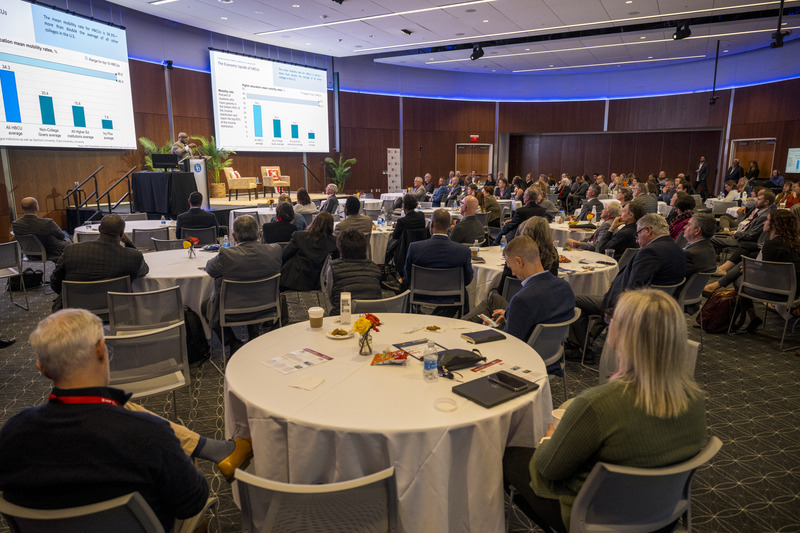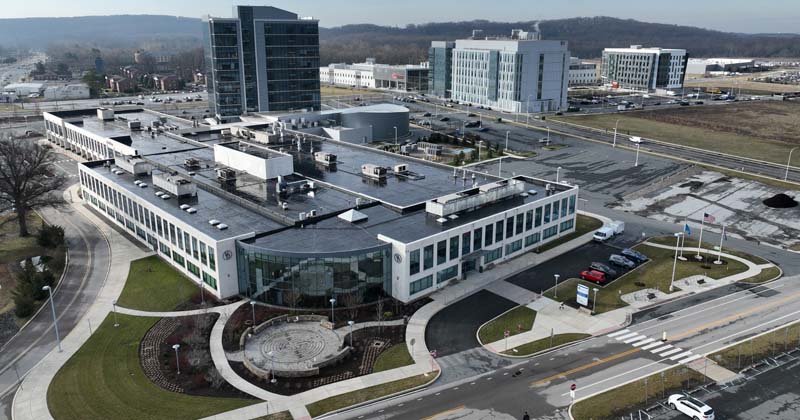STAR Campus shines during Association of University Research Park members’ visit
Norbert Mórucz traveled more than 4,400 miles to attend the 2023 international conference of the Association of University Research Parks in Delaware, Oct. 16-19. Mórucz is president of the Association of Science and Technology Parks in Budapest, Hungary, an association of 20 technology parks and 14 science parks.
A new AURP member and first-time conference attendee, Mórucz was eager to learn about U.S. models for technology and innovation park development, to network and to make connections with potential American partners.
“Universities today are not just for education and research, but also for technology development and innovation, and business,” Mórucz said. “We want to set up joint ventures, collaborate and provide a pipeline and soft landing for Europeans to come here, but need advice on how to go about this.”
With over 245 research park leaders and innovation district leaders in attendance, there were plenty of bright minds to tap for ideas at the conference, hosted this year by the University of Delaware and its Science, Technology and Advanced Research (STAR) Campus.
UD President Dennis Assanis welcomed the attendees to Delaware, noting the alignment between the conference theme of innovation powered by people, places and purpose and the culture developing across the STAR Campus.
He pointed out that UD’s STAR Campus is an example of innovation-based economic development, where public-private partnership in university-anchored ecosystems can help power the state’s economy, bolster business creation and innovation, and foster workforce-development and student success. With more than 30 companies on STAR and more than 1 million square feet of modern labs, classrooms, clinical spaces and offices, connected by greenspace, there is a neighborhood feel that encourages creativity, collaborations and community building.
“These kinds of technology and innovation hubs are at the heart of what I think is our modern-day land-grant mission. The ecosystem that grows up around a particular industry — for example, biopharmaceuticals here at STAR Campus — becomes self-perpetuating,” said Assanis, who was appointed by President Biden to the President’s Council of Advisors on Science and Technology. “Education spurs research and innovation, which draws entrepreneurs and builds engagement with the community, which increases the need for educated workers in that field, and so on.”
Valuable collision spaces
Brian Darmody, AURP chief strategy officer, is the author of several white papers on the value of research parks. He noted that innovation districts improve the likelihood that student talent remains in an area, instead of being recruited elsewhere after graduation. This happens when students get to experience the robust ecosystem and facilities early on through internships or work experiences, such as those available with STAR Campus partners and tenants. These students then become part of the community, finding jobs, paying taxes, buying homes, growing families and otherwise contributing to the local economy.
Situating a diversity of businesses, nonprofits and researchers in one space also increases what Darmody calls “bumpability,” the likelihood that a researcher from one discipline could bump into someone working in a different technology area and discover some common ground.
“UD’s STAR Campus is an example of a well-designed collaboratory, where people can have their own independent space but have lots of reasons to meet with other folks,” Darmody said.

The 2023 international conference of the Association of University Research Parks drew more than 240 research park leaders and innovation district leaders from around the world to UD’s Science Technology and Advanced Research (STAR) campus.
“When you put nonprofits, academia and private industry together in one ecosystem, innovation and research translation accelerates; student experience, learning and hiring grows,” said Tracy Shickel, associate vice president of corporate engagement at UD and AURP board member.
AURP visitors had the opportunity to tour leading-edge STAR Campus facilities, including NIIMBL — the National Institute for Innovation in Manufacturing Biopharmaceuticals. NIIMBL is a Manufacturing USA network of over 200 members headquartered in the Ammon Pinizzotto Biopharmaceutical Innovation Center and focused on improving biopharmaceuticals manufacturing and educating the future biopharmaceutical workforce. They also visited the FinTech Innovation Hub, the latest gem in UD’s innovation neighborhood, centered on work aimed at improving equity in financial services and health.
A moderated panel discussion on the transformative role of hydrogen in clean energy research provided AURP members an overview of cutting-edge technologies, applications and policies that will power a more sustainable future for society. UD is a trailblazer in this area, collaborating to accelerate technology development through its Center for Clean Hydrogen, launched in 2022, and building the region’s clean energy workforce through its role in the recently announced Mid-Atlantic Clean Hydrogen Hub.
Attendees also learned how corporate-university connections are changing the way JPMorgan Chase hires its technology talent. According to Jennifer McDermott, JPMC executive director of global technology workforce strategy, one out of every three employee roles at JPMC are tech related, amounting to about 55,000-60,000 technologists across the financial services company. These jobs are not only in high demand, but they are also higher-paying jobs.
Proximity to talent and diversity is key to sustaining a strong technology pipeline, she said, as are programs that provide alternative pathways for talent development. UD’s Spectrum Scholars, a college-to-career program designed to break down barriers to access for students with autism collaboratively developed by UD and JPMC, is one such example.
Gov. John Carney recalled Delaware’s evolution over the last 50 years from a state well-known for a few large employers, such as the DuPont Company and Chrysler, to a small business state with a bustling innovation-based economy.
“We knew to be successful as a state we had to diversify our economy. We had to get focused on small business and science and technology-based companies, and that’s what we did,” Carney said.
The transformation of UD’s STAR Campus — the site of a former Chrysler automotive plant — is a shining example of this in action. Today, more than 3,000 people work on the STAR Campus, a greater number than when the automotive plant was producing Dodge Durangos more than 20 years ago.
Delaware State University (DSU), a Historically Black College and University (HBCU) located in Dover, Delaware, is moving in the same direction, working to develop science and technology-based innovation and businesses, and preparing students to be leaders in the workforce of the future.

Keynote speaker Tony Allen, president of Delaware State University, a UD alumnus and former member of UD’s Board of Trustees, spoke about the wealth of talent in Historically Black Colleges and Universities (HBCUs) and the value they bring to powering an innovation pipeline.
“When you think about the ability to change lives across any discipline, think about how important it is to bring diversity of people, experience and ideas into the marketplace,” said Allen, who chairs President Biden’s Board of Advisors on Historically Black Colleges and Universities. “Think about what that will mean for our country and for our smaller, globally connected world and how you can partner with our HBCUs.”
Carney said there are reasons for Delaware’s success. Borrowing a phrase from his predecessor, former Gov. Jack Markell, Carney referred to Delaware as “a state of neighbors,” saying, “I just love that terminology, because we’re very small, barely one million people, and we have this tradition of knowing one another and working together to get things done.”
Efforts to shore up gaps in Delaware’s innovation ecosystem are an apt example of this. Take UD’s three University-related research campuses, for example: Delaware Technology Park and UD’s STAR Campus in Newark, and the Innovation Space in Wilmington.
“As companies or startups formed, and technologies were licensed, we had incubation space for them, but as they grew, they often had to move out of the region,” Shickel said.
Through partnerships with state elected officials, the university and commercial real estate market, those gaps have been filled, so that businesses like Prelude Therapeutics, a clinical-stage biopharmaceuticals company, now have support and space to expand. Prelude Therapeutics started at STAR Campus, grew to the Innovation Space, and now is putting its permanent headquarters at the Chestnut Run Innovation and Science Park (CRISP) campus in Wilmington, Delaware.
And while the development at STAR Campus has been tremendous over the last decade, Shickel said, with just over 10% of the 272 acres on the STAR campus currently developed, they’ve barely scratched the surface of what’s possible.
“This is a tremendous economic and innovation impact success story,” Shickel said.
Throughout the remainder of the conference, AURP members had the opportunity to visit a cross-section of other regional innovation ecosystem models with varying funding mechanisms, ownership models, missions, objectives and tenant mixes, including The Mill in Wilmington and the Brandywine Realty Trust in Philadelphia, Pennsylvania.
Article by Karen B. Roberts | Photos by Kathy F. Atkinson and Dave Levandoski (featured on UDaily, 10/16/2023)

